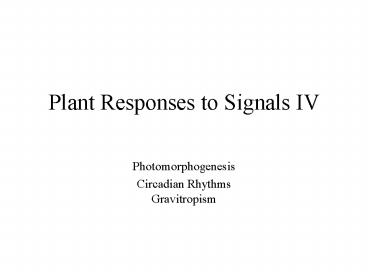Plant Responses to Signals IV - PowerPoint PPT Presentation
Title:
Plant Responses to Signals IV
Description:
erf: ethylene response factor. no transcription. Light is used by plants as a signal, as well as an energy source, ... Explain the importance of auxin in plants. ... – PowerPoint PPT presentation
Number of Views:84
Avg rating:3.0/5.0
Title: Plant Responses to Signals IV
1
Plant Responses to Signals IV
- Photomorphogenesis
- Circadian RhythmsGravitropism
http//sunflower.bio.indiana.edu/rhangart/plantsi
nmotion.html
2
Signal Transductiongeneral
Second messengers, - kinase cascades, -
calcium concentration, - etc.
Receptors, - G-protein linked, - enzyme
linked, - ion channel, - etc.
Responses, - gene expression (/-), -
membrane dynamics, - metabolism -
cytoskeleton - etc.
Signals, - hormone, - light, -
temperature, - gravity, - etc.
Fig. 39.2
3
no ethylene no triple response.
active
inactive
?
induces transcription,
no transcription
erf ethylene response factor.
4
Photomorphogenesis
- Light is used by plants as a signal, as well as
an energy source, - quantity,
- quality (wavelength),
- direction,
- duration.
- Germination (/-)
- Stem length (-)
- Leaf expansion ()
- Flowering (/-)
- Phototropism (/-)
- Stomatal opening ()
- Chloroplast development ()
- Pigment synthesis ()
- and more...
5
Action Spectra
- Action Spectrum,
- graph of the magnitude of a biological response
to light, - as a function of wavelength.
6
Molecular Switchlooking for a photoreceptor,
look for a photo-reversible pigment.
Fig. 39.18
7
Phytochromephotoreceptor molecule
dimer
Fig. 39.19
8
Phytochromephotoreceptor molecule
Quantity, Time, Quality.
Fig. 39.20
9
Phytochrome Location
Phtyochrome is a cytosolic protein.
10
Phytochromehas multiple functions,
- Seed Germination,
- Flowering time (photoperiodism),
- Entraining (setting) the biological clock,
- End of day,
- Stem elongation,
- Leaf Expansion,
- Pigment synthesis.
11
Photoperiodismflowering times,
Long-day plants, night breaks induce flowering.
Fig 39.22
12
Phytochromephotoperiodism,
Fig 39.22
13
Phytochrome
absorbtion spectra, the wavelengths absorbed by
specific pigments.
not phytochrome
14
Cryptochromes
- blue light photoreceptors (I),
- evolved from a light dependent DNA repair
enzyme, - ...across phylogeny, these proteins have been
used for many functions, - ranging from blue-light-dependent development in
plants, - blue-light-mediated phase shifting of the
circadian clock in insects, - to a core circadian clock component in mammals.
15
Phototropinsmediate phototropism,
- blue light photoreceptors II,
- contribute to stem, root and leaf movements in
response to directional information, - also contributes to the alignment of
chloroplasts within mesophyll cells, - to maximize light gathering capacity,
- and to minimize light damage at high
irradiances.
Phototropism action spectrum
16
Concept Map
Functions
Photoreversible
Phytochrome
Cryptochrome
Photoperiodism
Phototropin
Action Spectra
17
Circadian Rhythms
- Relating to, or exhibiting approximately 24-hour
periodicity, - circa around dies day.
- Internal Biochemical Oscillators,
- found in all eukaryotes,
- eubacteria as well.
sleep movements
Fig 39.21
18
Circadian Rhythms
of response,
Circadian processes continue even if light (or
dark) is continuous...
Entrainment
amplitude and period entrainment is
continuous, - allows fine control.
19
- 480 of 8,000 (tested) genes are under circadian
control, - 1,500 (estimated) Arabidopsis genes, or 6
follow circadian cycles of expression.
20
Photosynthesis genes...
Secondary metabolism (wood, defense).
21
Gravitropism
- the gravity directed growth processes that
direct root and shoot orientation during a plants
life-cycle,
- about 1.7, or roughly 500 genes, are transcribed
in Arabidopsis when it is re-oriented 90o.
22
Gravitropic Set Point
180o
90o
0o
Plant organs orient themselves to the gravity
vector.
23
Starch Statolith Hypothesis
http//www.biosci.ohio-state.edu/plantbio/Sacklab
/timelapse.html
- Re-orientation of heavy starch grains signals
gravity vector.
Fig 39.25
24
Final
- All material since Lecture 11 (Reproduction),
- lecture, book and other assigned readings (i.e.
- Review 5 pm Monday, (will post room on WEB),
- Final, here in this room
- Tuesday 11/9, 1030 1230.
25
Assigned Essays
- Explain the importance of auxin in plants. How it
is signaled, what are some of its function, where
is it made, how is it transported? Give an
example how it interacts with other hormones. - Why would a plant want to prevent self
pollination? Discuss two mechanisms used by
angiosperms to avoid self fertilization. - Give examples of heterospory and homospory and
explain the differences between the two,
mentioning the evolutionary significance. - Describe how phase changes are used by
developmental biologists to uncover biological
processes. - Describe how plants use light and hormones to
influence the germination of the seed. - What is phytochrome?
26
Assigned Essays
- Explain the importance of auxin in plants. How it
is signaled, what are some of its function, where
is it made, how is it transported? Give an
example how it interacts with other hormones. - Why would a plant want to prevent self
pollination? Discuss two mechanisms used by
angiosperms to avoid self fertilization. - Give examples of heterospory and homospory and
explain the differences between the two,
mentioning the evolutionary significance. - Describe how phase changes are used by
developmental biologists to uncover biological
processes. - Describe how plants use light and hormones to
influence the germination of the seed. - What is phytochrome?

